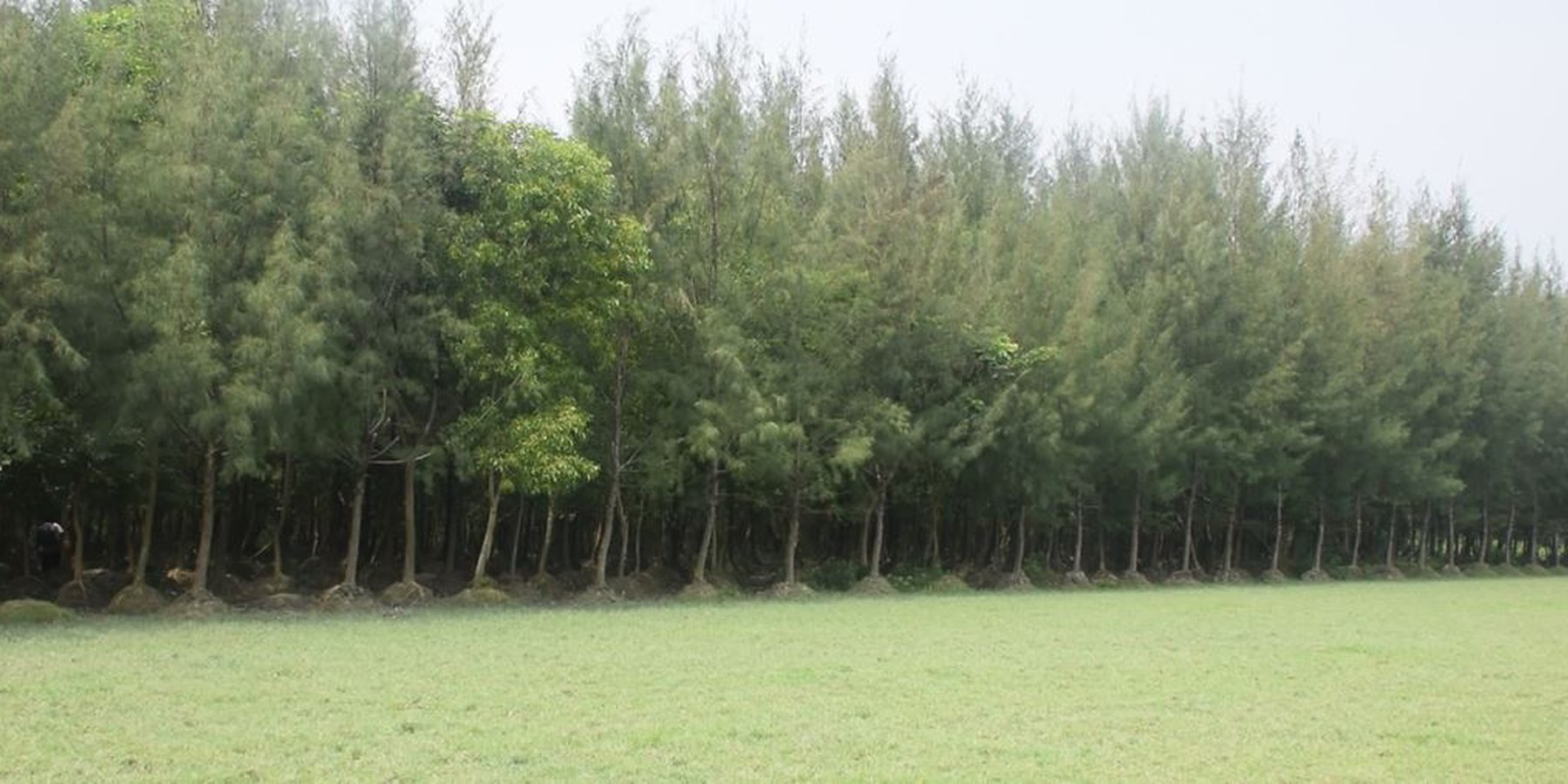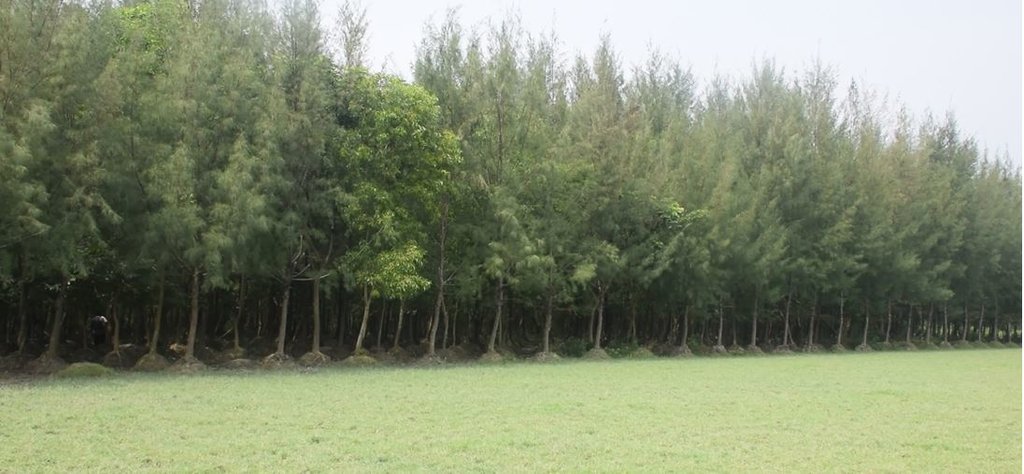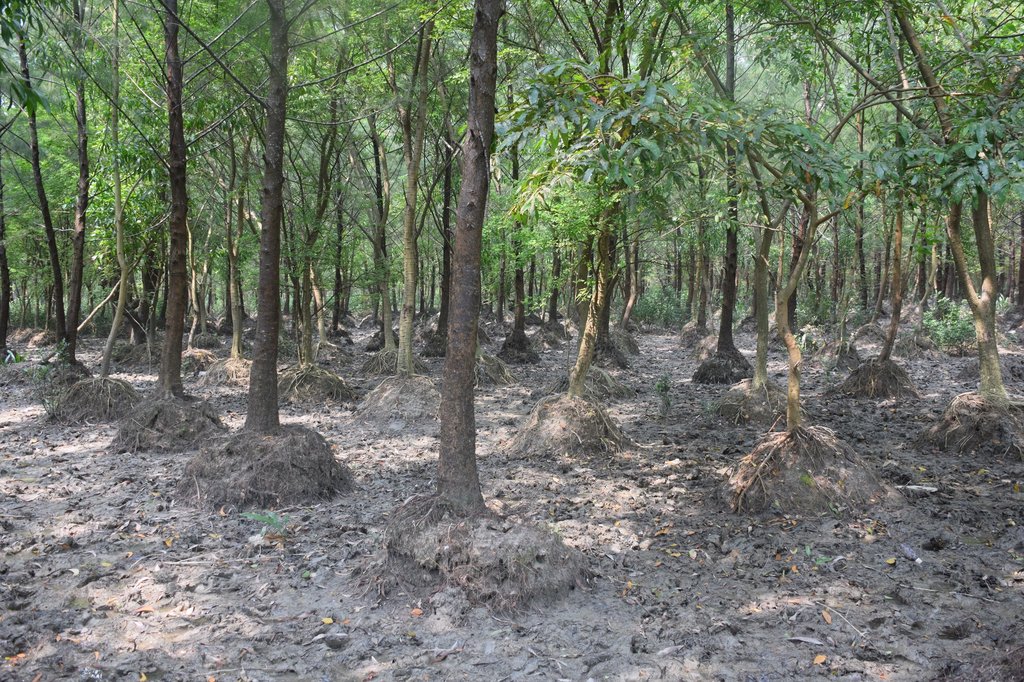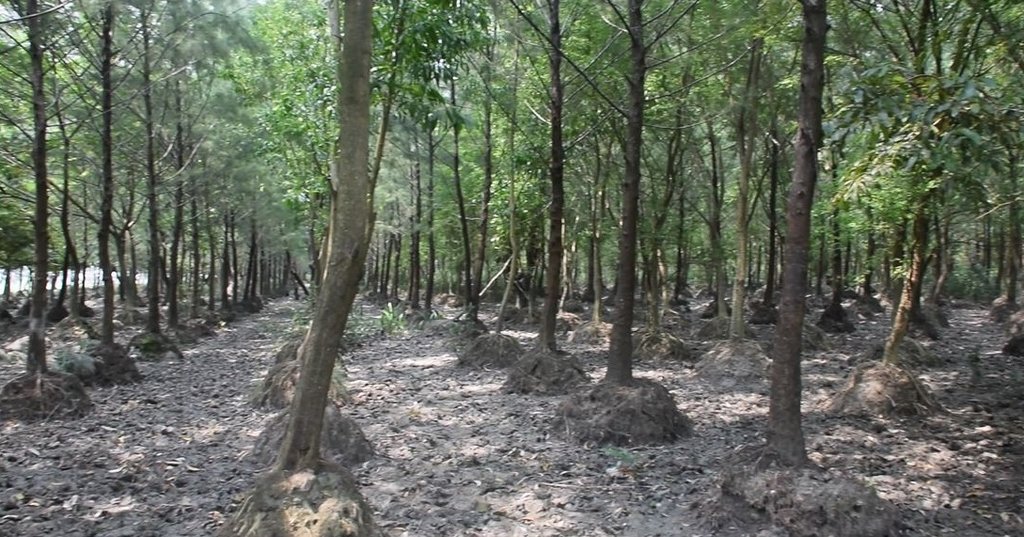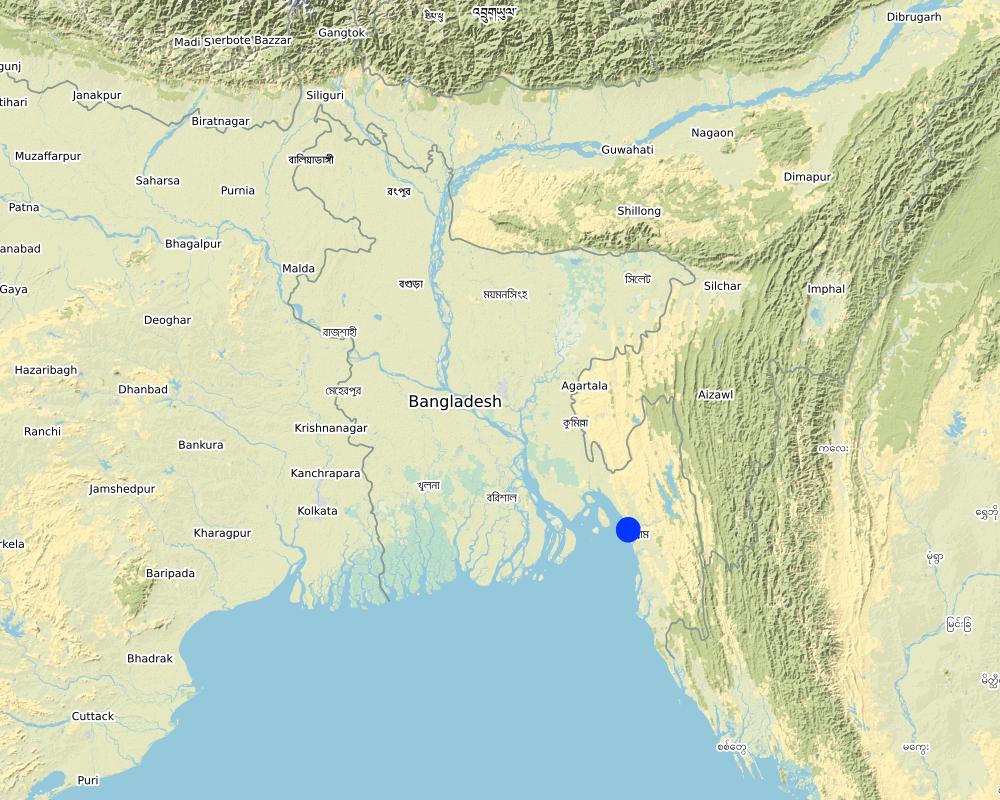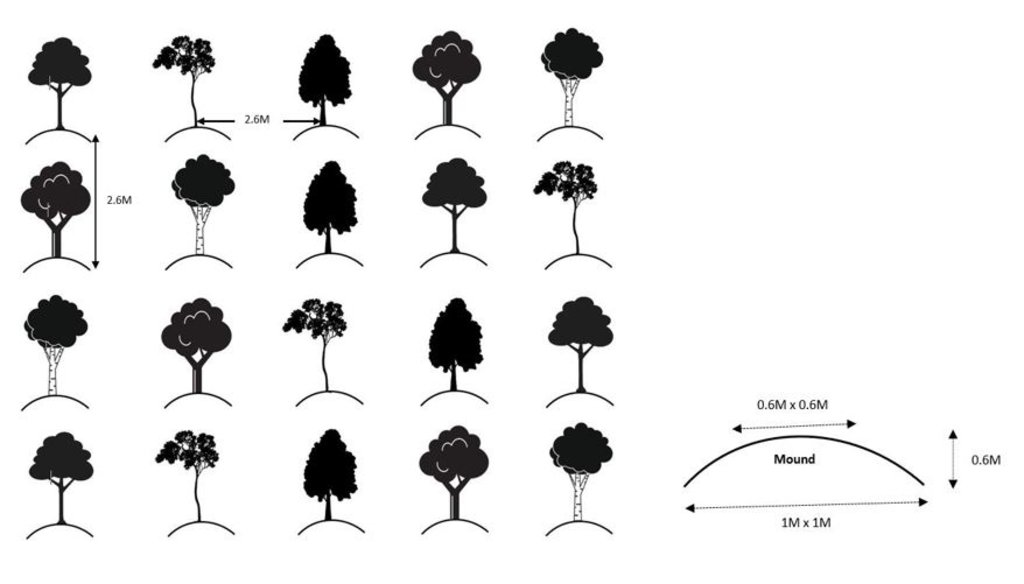Mound plantation in coastal area with non-mangrove plant species for land stabilization [孟加拉国]
- 创建:
- 更新:
- 编制者: Fazlay Arafat
- 编辑者: Mutasim Billah, Md. Jakir Hossain, Md. Arfanuzzaman
- 审查者: Nicole Harari, Rima Mekdaschi Studer, Ursula Gaemperli
Mound plantation
technologies_4732 - 孟加拉国
查看章节
全部展开 全部收起1. 一般信息
1.2 参与该技术评估和文件编制的资源人员和机构的联系方式
关键资源人
SLM专业人员:
Md. Anowar Hossain
Bangladesh Forest Department
孟加拉国
土地使用者:
Mohammad Rahman
Local community people
孟加拉国
有助于对技术进行记录/评估的项目名称(如相关)
Decision Support for Mainstreaming and Scaling out Sustainable Land Management (GEF-FAO / DS-SLM)有助于对技术进行记录/评估的机构名称(如相关)
Bangladesh Forest Department (Bangladesh Forest Department) - 孟加拉国有助于对技术进行记录/评估的机构名称(如相关)
FAO Bangladesh (FAO Bangladesh) - 孟加拉国1.3 关于使用通过WOCAT记录的数据的条件
编制者和关键资源人员接受有关使用通过WOCAT记录数据的条件。:
是
1.4 所述技术的可持续性声明
这里所描述的技术在土地退化方面是否存在问题,导致无法被认为是一种可持续的土地管理技术?:
否
2. SLM技术的说明
2.1 技术简介
技术定义:
Mound plantation with non-mangrove species to transform mono-culture plantations subsequently into more ecologically resilient, mixed species plantations and as well as to accelerate natural processes of accretion and land stabilization in coastal areas.
2.2 技术的详细说明
说明:
Bangladesh has nearly five decades of experience of coastal afforestation and reforestation on offshore islands and newly accreted lands. Coastal plantations were originally planted mainly to protect coastal populations against tidal bores, cyclones and storm surges and as well as to speed up the stabilization of newly accreted lands that eventually protect interior agricultural land from saline intrusion. According to the historical approaches to coastal afforestation and reforestation in Bangladesh, only a few pioneer mangrove species are suitable for planting on newly accreted coastal lands. Mangrove plantations that were established with a handful of pioneer species require increasing levels of management to promote ‘artificial succession’. There is need to transform these predominantly monoculture plantations subsequently into more ecologically resilient, mixed species plantations. Mound plantation with non-mangrove species was introduced in some places to address this issue.
Under the ‘Climate Resilient Participatory Afforestation and Reforestation Project’ non-mangrove mound plantations were established in 2013 in South Salimpur area of Sitakundu upazila (administrative unit) in Chittagong district by the Forest Department. Earlier, in 1983 the newly accreted char land (river islands formed from sedimentation) was planted with mangrove species Keora (Sonneratia apetala). Mangroves are salt-tolerant trees that cope with salt water immersion and wave action and are adapted to life in waterlogged and harsh coastal conditions. Due to cyclones and illegal removal of trees the Keora plantations were destroyed in many spots. In the meantime, the mangroves had accumulated sediments and the land was raised as compared to the adjacent inland areas. This accreted and stabilized land is suitable for non-mangrove plantation as the water does not flood the raised land regularly.
However, the area is regularly inundated by the tide during the monsoon. In addition storm surges flood the land and cause waterlogged conditions, which are not suitable for the survival of non-mangrove species. To successfully plant non-mangrove species along the coast, mound plantation is practiced. The mound served as a raised bed to protect the seedlings from waterlogged conditions in monsoon seasons. Akashmoni (Acacia auriculiformis), Jhau (Casuarina equisetifolia), Arjun (Terminalia arjuna), Rain-tree (Albizia saman), Babla (Vachellia nilotica) tree species are planted in mound. The major activities of this practice are cleaning of site from weeds & making of round shaped mounds. The diameter of the mound in the base is 1m and in top is 0.6m with a height of 0.6m. The mound is prepared through soil heaps from the plantation site. Inter and intra row spacing is 2.6m x 2.6m center to center of the mounds. 1500 mounds per hectare are constructed and one bamboo stick put inside every mound to support the plated seedlings to stand firmly.
The dimension of pit in each mound is 0.3m x-0.3m s 0.3m and the pit needs to be kept open for two weeks for drying before the one year old seedling can be transplanted in the pits. The seedlings were raised in the nursery of Forest Department under the project. While planting seedlings 0.5 kg compost and 0.5 kg loamy soil are mixed in the pit to increase the fertility of the soil. Vacancy filling is required in the next year and weeding practice continues till 3rd year of plantation.
Advantage of mixed-species over monocultures is the promotion of diversifying production under different rotation periods. Mixed-species plantations are more resistant to damage caused by storms, insects or diseases. Mound plantation with non-mangrove mixed species increased the diversity and ecological services. Mound plantations are vulnerable to a variety of threats from livestock grazing, mainly buffalo, to extraction of timber and outright conversion of plantations to other land uses such as agriculture, aquaculture and salt production.
However, the mound plantation practice contributes in coastal greenbelt species diversification along with speed up the natural processes of accretion and land stabilization.
2.3 技术照片
2.5 已应用该技术的、本评估所涵盖的国家/地区/地点
国家:
孟加拉国
区域/州/省:
Chittagong district
有关地点的进一步说明:
Kattoli coast area
具体说明该技术的分布:
- 均匀地分布在一个区域
如果不知道精确的区域,请注明大致覆盖的区域:
- 0.1-1 平方千米
技术现场是否位于永久保护区?:
否
Map
×2.6 实施日期
如果不知道确切的年份,请说明大概的日期:
- 不到10年前(最近)
2.7 技术介绍
详细说明该技术是如何引入的:
- 通过项目/外部干预
注释(项目类型等):
Climate Resilient Participatory Afforestation and Reforestation Project’ by the Forest Department established the technology
3. SLM技术的分类
3.1 该技术的主要目的
- 减少、预防、恢复土地退化
- 降低灾害风险
3.2 应用该技术的当前土地利用类型
同一土地单元内混合使用的土地::
否

森林/林地
- 植树造林
植树造林:说明树种的起源和组成:
- 混交品种
- Coastal afforestation with non-mangrove plant species
树木类型:
- 大叶相思
- 木麻黄
- Terminalia Arjuna, Albizia Saman, Vachellia nilotica
以上的树木是落叶树还是常绿树?:
- 常绿
产品和服务:
- 木材
- 薪材
- 自然保持/保护
- 娱乐/旅游
- 自然灾害防护
3.3 由于技术的实施,土地使用是否发生了变化?
由于技术的实施,土地使用是否发生了变化?:
- 是(请在技术实施前填写以下有关土地利用的问题)
同一土地单元内混合使用的土地::
否

不毛之地
具体说明:
Earlier the area was covered with mangroves species but due to cyclones and illegal logging the mangrove stand destroyed and the area turned to an unproductive land. However, the mangroves had stabilized the accredited land raised the land due to sediment deposition.
注释:
Only some mangrove plant species found in scatter
3.4 供水
该技术所应用土地的供水:
- 雨养
3.5 该技术所属的SLM组
- 森林种植管理
- 防风林/防护林带
- 减少基于生态系统的灾害风险
3.6 包含该技术的可持续土地管理措施

植物措施
- V1:乔木和灌木覆盖层
3.7 该技术强调的主要土地退化类型

土壤水蚀
- Wc:海岸侵蚀

化学性土壤退化
- Cs:盐化/碱化
3.8 防止、减少或恢复土地退化
具体数量名该技术与土地退化有关的目标:
- 减少土地退化
- 修复/恢复严重退化的土地
注释:
Plant varieties that comes through natural succession process stabilize the newly formed coastal land. Mound plantation with non-mangrove species strengthen that process with other plantation services.
4. 技术规范、实施活动、投入和成本
4.1 该技术的技术图纸
技术规范(与技术图纸相关):
The dimensions of structures are explained in the description part
作者:
Md. Fazlay Arafat
日期:
06/05/2019
4.2 有关投入和成本计算的一般信息
具体说明成本和投入是如何计算的:
- 每个技术区域
注明尺寸和面积单位:
1 ha
如果使用本地面积单位,注明转换系数为1公顷(例如1公顷=2.47英亩):1公顷=:
1 ha=2.47 acres
其它/国家货币(具体说明):
BDT
如相关,注明美元与当地货币的汇率(例如1美元=79.9巴西雷亚尔):1美元=:
84.0
注明雇用劳工的每日平均工资成本:
500 BDT
4.3 技术建立活动
| 活动 | 时间(季度) | |
|---|---|---|
| 1. | Nursery establishment | October-November |
| 2. | Raising seedlings | January-February |
| 3. | Site preparation: clearing of site and mound construction | April-May |
| 4. | Transplantation of seedlings | June |
| 5. | Fertilizer application: Compost mixed with loamy loamy soil | June |
4.4 技术建立所需要的费用和投入
| 对投入进行具体说明 | 单位 | 数量 | 单位成本 | 每项投入的总成本 | 土地使用者承担的成本% | |
|---|---|---|---|---|---|---|
| 劳动力 | Nursery preparation | person-days | 17.0 | 500.0 | 8500.0 | 100.0 |
| 劳动力 | Earth clearing and mound preparation | person-days | 150.0 | 500.0 | 75000.0 | 100.0 |
| 劳动力 | Plantation work | person-days | 25.0 | 500.0 | 12500.0 | 100.0 |
| 设备 | Bucket | pieces | 15.0 | 250.0 | 3750.0 | 100.0 |
| 设备 | Spade | pieces | 15.0 | 500.0 | 7500.0 | 100.0 |
| 植物材料 | Seeds for nursery bed | Lump sum | 1.0 | 1000.0 | 1000.0 | 100.0 |
| 植物材料 | Poly bags | Pieces | 1800.0 | 1.0 | 1800.0 | 100.0 |
| 植物材料 | Bamboo stick to support seedlings | Pieces | 1600.0 | 2.0 | 3200.0 | 100.0 |
| 肥料和杀菌剂 | Compost to apply in plantation | kg | 1000.0 | 4.0 | 4000.0 | 100.0 |
| 肥料和杀菌剂 | Urea for poly bag seedling | kg | 4.0 | 35.0 | 140.0 | 100.0 |
| 肥料和杀菌剂 | TSP for poly bag seedling | kg | 4.0 | 40.0 | 160.0 | 100.0 |
| 肥料和杀菌剂 | MoP for poly bag seedling | kg | 4.0 | 30.0 | 120.0 | 100.0 |
| 施工材料 | Bamboo for nursery fencing | pieces | 4.0 | 250.0 | 1000.0 | 100.0 |
| 其它 | Seedling transportation cost | Lump-sum | 1.0 | 1000.0 | 1000.0 | 100.0 |
| 技术建立所需总成本 | 119670.0 | |||||
| 技术建立总成本,美元 | 1424.64 | |||||
4.5 维护/经常性活动
| 活动 | 时间/频率 | |
|---|---|---|
| 1. | Vacancy filling | June |
| 2. | 1st year weeding | 3 times in a year |
| 3. | 2nd year weeding | 3 times in a year |
| 4. | 3rd year weeding | 2 times in a year |
| 5. | Fertilizer application to the newly planted trees | June |
4.6 维护/经常性活动所需要的费用和投入(每年)
| 对投入进行具体说明 | 单位 | 数量 | 单位成本 | 每项投入的总成本 | 土地使用者承担的成本% | |
|---|---|---|---|---|---|---|
| 劳动力 | Seedling transportation | person-days | 1.0 | 500.0 | 500.0 | 100.0 |
| 劳动力 | Vacancy filling | person-days | 4.0 | 500.0 | 2000.0 | 100.0 |
| 劳动力 | Fertilizer application to the newly planted trees | person-days | 4.0 | 500.0 | 2000.0 | 100.0 |
| 劳动力 | Weeding | person-days | 40.0 | 500.0 | 20000.0 | 100.0 |
| 植物材料 | Bamboo stick to support seedlings | pieces | 350.0 | 2.0 | 700.0 | 100.0 |
| 肥料和杀菌剂 | NPK fertilizer | kg | 75.0 | 30.0 | 2250.0 | 100.0 |
| 技术维护所需总成本 | 27450.0 | |||||
| 技术维护总成本,美元 | 326.79 | |||||
4.7 影响成本的最重要因素
描述影响成本的最决定性因素:
Labor
5. 自然和人文环境
5.1 气候
年降雨量
- < 250毫米
- 251-500毫米
- 501-750毫米
- 751-1,000毫米
- 1,001-1,500毫米
- 1,501-2,000毫米
- 2,001-3,000毫米
- 3,001-4,000毫米
- > 4,000毫米
农业气候带
- 潮湿的
5.2 地形
平均坡度:
- 水平(0-2%)
- 缓降(3-5%)
- 平缓(6-10%)
- 滚坡(11-15%)
- 崎岖(16-30%)
- 陡峭(31-60%)
- 非常陡峭(>60%)
地形:
- 高原/平原
- 山脊
- 山坡
- 山地斜坡
- 麓坡
- 谷底
垂直分布带:
- 0-100 m a.s.l.
- 101-500 m a.s.l.
- 501-1,000 m a.s.l.
- 1,001-1,500 m a.s.l.
- 1,501-2,000 m a.s.l.
- 2,001-2,500 m a.s.l.
- 2,501-3,000 m a.s.l.
- 3,001-4,000 m a.s.l.
- > 4,000 m a.s.l.
说明该技术是否专门应用于:
- 不相关
5.3 土壤
平均土层深度:
- 非常浅(0-20厘米)
- 浅(21-50厘米)
- 中等深度(51-80厘米)
- 深(81-120厘米)
- 非常深(> 120厘米)
土壤质地(表土):
- 细粒/重质(粘土)
土壤质地(地表以下> 20厘米):
- 细粒/重质(粘土)
表土有机质:
- 低(<1%)
5.4 水资源可用性和质量
地下水位表:
< 5米
地表水的可用性:
过量
水质(未处理):
不可用
水质请参考::
地下水和地表水
水的盐度有问题吗?:
是
具体说明:
Due to regular tidal inundation the soil become saline and only support to grow mangrove plant species
该区域正在发生洪水吗?:
是
规律性:
偶然
5.5 生物多样性
物种多样性:
- 低
栖息地多样性:
- 低
5.6 应用该技术的土地使用者的特征
定栖或游牧:
- 定栖的
生产系统的市场定位:
- 混合(生计/商业)
非农收入:
- 收入的10-50%
相对财富水平:
- 贫瘠
个人或集体:
- 员工(公司、政府)
机械化水平:
- 手工作业
性别:
- 女人
- 男人
土地使用者的年龄:
- 青年人
- 中年人
- 老年人
说明土地使用者的其他有关特征:
Bangladesh Forest Department established the coastal plantation through participatory approach of co-management with adjacent local communities.
5.7 应用该技术的土地使用者使用的平均土地面积
- < 0.5 公顷
- 0.5-1 公顷
- 1-2 公顷
- 2-5公顷
- 5-15公顷
- 15-50公顷
- 50-100公顷
- 100-500公顷
- 500-1,000公顷
- 1,000-10,000公顷
- > 10,000公顷
这被认为是小规模、中规模还是大规模的(参照当地实际情况)?:
- 小规模的
5.8 土地所有权、土地使用权和水使用权
土地所有权:
- 州
土地使用权:
- 社区(有组织)
用水权:
- 自由进入(无组织)
土地使用权是否基于传统的法律制度?:
否
5.9 进入服务和基础设施的通道
健康:
- 贫瘠
- 适度的
- 好
教育:
- 贫瘠
- 适度的
- 好
技术援助:
- 贫瘠
- 适度的
- 好
就业(例如非农):
- 贫瘠
- 适度的
- 好
市场:
- 贫瘠
- 适度的
- 好
能源:
- 贫瘠
- 适度的
- 好
道路和交通:
- 贫瘠
- 适度的
- 好
饮用水和卫生设施:
- 贫瘠
- 适度的
- 好
金融服务:
- 贫瘠
- 适度的
- 好
6. 影响和结论性说明
6.1 该技术的现场影响
社会经济效应
生产
木材生产
森林/林地质量
生产故障风险
注释/具体说明:
Due to diversified non-mangrove species used in the plantation the risk of failure reduced
生产区域
注释/具体说明:
Mound plantation increase production area through converting unproductive land areas
土地管理
注释/具体说明:
Once established, the non-mangrove species do not require much silvicultural operation
社会文化影响
娱乐机会
注释/具体说明:
The spot become popular to tourist
SLM/土地退化知识
生态影响
水循环/径流
地表径流
注释/具体说明:
surface runoff decrease as raised mounds acts as a barrier
蒸发
土壤
土壤覆盖层
土壤流失
注释/具体说明:
Soil loss with water decreased as mounds reduces surface runoff
土壤堆积
土壤有机物/地下C
生物多样性:植被、动物
植被覆盖
生物量/地上C
植物多样性
有益物种
栖息地多样性
害虫/疾病控制
减少气候和灾害风险
洪水影响
注释/具体说明:
flood impact decreases as the mound forest act as a barrier and protect the raised land
碳和温室气体的排放
风速
6.2 该技术的场外影响已经显现
风力搬运沉积物
温室气体的影响
6.3 技术对渐变气候以及与气候相关的极端情况/灾害的暴露和敏感性(土地使用者认为的极端情况/灾害)
渐变气候
渐变气候
| 季节 | 增加或减少 | 该技术是如何应对的? | |
|---|---|---|---|
| 年温度 | 增加 | 好 | |
| 季雨量 | 湿季/雨季 | 增加 | 好 |
气候有关的极端情况(灾害)
气象灾害
| 该技术是如何应对的? | |
|---|---|
| 热带风暴 | 适度 |
| 局地暴雨 | 好 |
| 局地雷暴 | 好 |
水文灾害
| 该技术是如何应对的? | |
|---|---|
| 风暴潮/沿海洪水 | 好 |
生物灾害
| 该技术是如何应对的? | |
|---|---|
| 流行病 | 适度 |
| 昆虫/蠕虫侵扰 | 适度 |
其他气候相关的后果
其他气候相关的后果
| 该技术是如何应对的? | |
|---|---|
| 海平面上升 | 适度 |
6.4 成本效益分析
技术收益与技术建立成本相比如何(从土地使用者的角度看)?
短期回报:
消极
长期回报:
非常积极
技术收益与技术维护成本/经常性成本相比如何(从土地使用者的角度看)?
短期回报:
消极
长期回报:
非常积极
6.5 技术采用
- 1-10%
在所有采用这项技术的人当中,有多少人是自发的,即未获得任何物质奖励/付款?:
- 91-100%
6.6 适应
最近是否对该技术进行了修改以适应不断变化的条件?:
否
6.7 该技术的优点/长处/机会
| 土地使用者眼中的长处/优势/机会 |
|---|
| The mixed plantation is now more pest resistance |
| The aesthetic beauty is increased and attract more tourists |
| 编制者或其他关键资源人员认为的长处/优势/机会 |
|---|
| The mixed stand with mound plantation supports more ecological services like supply of fuel wood, wildlife habitat, timber, tourism, greenbelt, etc. |
| Species mixtures maximize the use of resources, and consequently increase stand-level productivity and carbon sequestration. |
| Speed up the natural succession process. Otherwise it takes long period of time to grow non-mangrove species in coastal areas. |
6.8 技术的弱点/缺点/风险及其克服方法
| 土地使用者认为的弱点/缺点/风险 | 如何克服它们? |
|---|---|
| The mounds often requires to be repaired when it faces frequent tropical storms and storm surges | |
| Grazing hampers the stand at the initial stage | Community awareness |
| 编制者或其他关键资源人员认为的弱点/缺点/风险 | 如何克服它们? |
|---|---|
| Only salt tolerant plant species can be planted |
7. 参考和链接
7.1 信息的方法/来源
- 实地考察、实地调查
Number of field visit:02
- 与土地使用者的访谈
Number of informants: 03
- 与SLM专业人员/专家的访谈
Number of informants: 02
7.2 参考可用出版物
标题、作者、年份、ISBN:
N/A
7.3 链接到网络上的相关信息
标题/说明:
N/A
7.4 一般注释
WOCAT questionnaire covers all the technical aspect of the practice
链接和模块
全部展开 全部收起链接
无链接
模块
无模块


